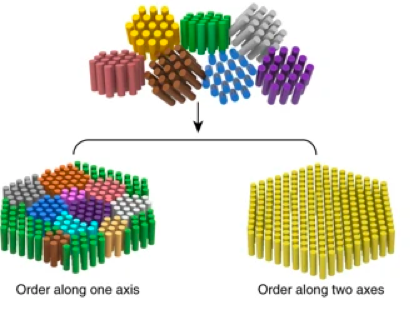Researchers Achieve Large-area Single Crystal in a Self-assembled Soft Material

By Lauren Salig
Controlling structural order in materials is important to optimize their properties in practical applications. In hard materials, like metal alloys or silicon, scientists have mastered this challenge and are able to control the alignment and position of atoms and molecules in crystalline lattices with such fidelity that an entire macroscale structure can be considered to be made out of a single crystal of the material. The aviation industry, for example, relies on single-crystal metal alloys to make turbine blades that can withstand higher operating temperatures, leading to better jet engine efficiency. Likewise, microelectronics require single-crystal silicon for reliable memory devices and processors.
For soft materials, however, scientists largely lack the ability to manipulate microstructural order with the same efficacy. While some soft materials have been manipulated into a single-crystal texture, this has been achieved only on small scales and with considerable effort.
Now, researchers have published a study in the journal Nature Materials that demonstrates a new way of achieving this level of control in soft materials.

The study was conducted by Chinedum Osuji, Eduardo D. Glandt Presidential Professor in the Department of Chemical and Biomolecular Engineering, along with Xunda Feng and Kohsuke Kawabata, who were postdoctoral researchers with Osuji at Yale University when the research was conducted.
“In general, scientists seek to produce single crystals for a variety of reasons,” Osuji says. “Two of the strongest are, first, because the properties of materials are often best understood at a fundamental level in the single-crystal state, and second, to leverage the unique properties that some materials display in their single-crystal states in practical applications.”
Coaxing materials into a single crystal can enable better performance in everyday devices. Single-crystal silicon is useful for computer chips, for example, because electrons can flow unimpeded by grain boundaries, the interfaces between regions in the material with different crystal orientations. Likewise, some single-crystal soft materials, such as block copolymers, are of interest for use in digital storage, but due to the difficulty of creating single crystals by aligning the microstructure of these materials, the full extent of their potential is yet to be realized.
Osuji and his colleagues set out to find new ways of doing that microstructure alignment.
“The system we studied is called a ‘columnar discotic mesophase,’” Osuji says. “That means it’s a system that is composed of disc-like molecules that stack into columns that are then packed in an orderly fashion, in this case, hexagonally. The hexagonal packing is similar to what you see if you pack a layer or oranges or tennis balls together closely.
“We realized that the tilt of the discs provided a means to control the orientation of the hexagonal lattice on which the columns sat,” he says.
The fundamental challenge the researchers faced was achieving microstructure alignment in more than one direction. They needed to control the orientation of the hexagonal lattice while also controlling the orientation of the columns themselves.
The researchers combined two techniques to get their soft material to assemble itself into the desired single crystal structure: physical confinement and magnetic fields. By confining the material to a thin film while applying a magnetic field, the team established a method that could reliably create single crystals of their material at a macroscale level of greater than 10 square centimeters.
Osuji believes this breakthrough is the first step in achieving highly ordered arrays of other materials of interest and in learning how soft materials in this state could best be utilized in real-world applications.
“Arrays of inorganic materials produced from single-crystal templates are of interest for high density storage and for fabrication of metamaterials,” says Osuji. “Another goal is to use the single crystals we generated as seeds for growth of even larger single crystals.”
Read the paper at Nature Materials, and learn more about Osuji’s research on his lab website.
This work was supported by the National Science Foundation through grants DMR-1410568, CMMI-1246804, and PFI:AIR-TT IIP 1640375.
